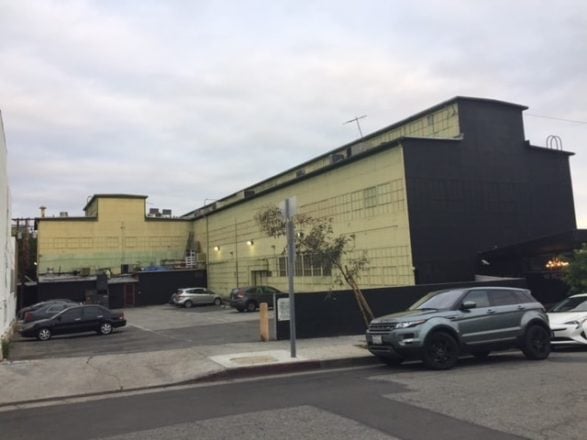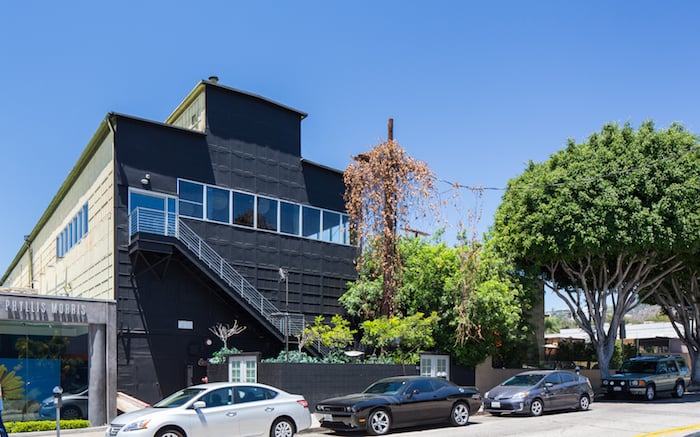
The Factory building was built in 1929 and existed as several businesses before opening as Studio One, a pioneering gay club, in 1974. It was renamed The Factory in the 1990s. Photo: Q Voice News.
UPDATE: The Factory was demolished in late summer 2020.
WEST HOLLYWOOD — The LGBTQ community has lost another space.
The Factory in West Hollywood, located on a 1.94 acre parcel of land that connects La Peer Drive and Robertson Boulevard, has been a gay club and safe space for 44 years.
The Factory is a historic building
In 1974 — one year after the American Psychiatric Association declassified homosexuality as a mental disorder — the industrial building was turned into Studio One, a pioneering gay disco where men socialized and openly celebrated their identity. In the early 1980s, Studio One hosted one of the nation’s first major fundraisers for AIDS research.
The Factory is listed on the California State Register of Historic Places and is the first LGBTQ site west of Chicago to be deemed eligible for listing on the National Register of Historic Places.
Jason Illoulian’s demolition plans
However, Jason Illoulian, CEO of Faring Capital, a West Hollywood-based real estate and development group, wants to demolish more than 60 percent of the historic Factory and replace it with a 114-foot, 241-room hotel and retail complex with 750 underground parking spaces. Illoulian also wants to dismantle, move, reassemble, and rotate the remains of the building, positioning it parallel to Robertson Boulevard.

Faring Capital’s Jason Illoulian plans to demolish the iconic, historic West Hollywood gay club The Factory (seen here in an east side view from Robertson Boulevard) and replace it with a hotel and retail shopping complex. Photo: File photo.
Preservation efforts
Illoulian has said that his Robertson Lane Project would preserve the building and highlight the building’s legacy; however, preservationists, including Kate Eggert and Kris Gosney of the West Hollywood Heritage Project, the leading advocates who have been trying to save the Factory since 2015, have said Illoulian’s proposed actions would jeopardize conservation efforts and the structure’s integrity.
“By altering the building so much, it will be difficult to have it designated historic,” Eggert said.
“The Factory is important because we have history,” Gosney said. “It’s American history. We are American, and we have shaped American history.”
Eggert and Gosney operate the Facebook page Save the Factory West Hollywood and have completed an impressive amount of comprehensive research on the Factory, including the 127-page nomination application that got it listed on the state and national registers.
Mitchell Camera
Apart from having significance for the LGBTQ community, the Factory’s legacy is rooted in film-industry history.
The Factory is a Truscon Steel Company-designed industrial building built in 1929 for the Mitchell Camera Corporation, whose cameras revolutionized filmmaking. By minimizing noise and maximizing functionality, the cameras enabled films to go from silent to “talkies,” and continued to influence camera technology until the digital era arrived in the early 2000s.
After the camera company changed locations in 1946, The Factory was converted to a variety of uses, including a cosmetics warehouse, a furniture showroom, an antique market, and an experimental theater.
City Council approves destruction
Earlier this month, the West Hollywood City Council approved Illoulian’s wrecking ball plans in a 4-1 vote. Mayor John Duran, Mayor Pro Tempore John D’Amico, and Councilman John Heilman and (who all identify as gay and shared stories of spending numerous nights dancing, partying, and enjoying the safe confines at Studio One in the 1980s) supported the Robertson Lane Project. Councilwoman Lindsey Horvath voted with the majority.
‘The Factory is an asset’
The lone vote against the development was Councilwoman Lauren Meister.
“I’m not convinced that the Factory is being preserved at the standards of the state or national registry,” she said. “For years, I’ve heard that the Factory is a detriment to the project. Actually, it’s an asset to the project. The Factory building gives the project its character. It’ says loud and proud, this is West Hollywood.”
Meister also acknowledged the efforts of the West Hollywood Preservation Alliance, L.A. Conservancy, and the National Trust for Historic Preservation, who all said they wanted to help save the building, but supported Illoulian’s plans. Meister wondered if they did a disservice to the LGBT community.
“I wonder, based on the history of the building and importance to the LGBT community, if you didn’t sell yourself short,” Meister said. “Without this building, the Robertson Lane Project is just another project.”
Illoulian has not yet said when The Factory will close or demolition will begin.
